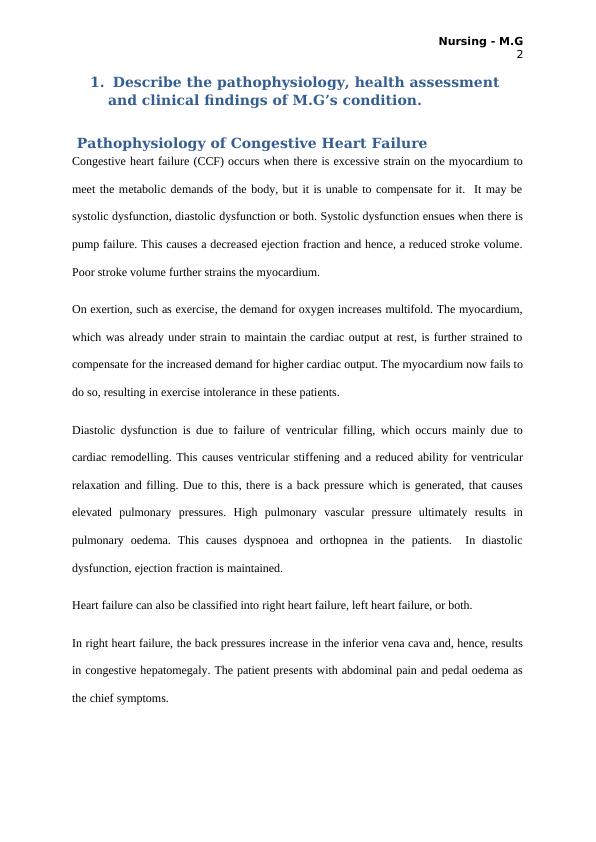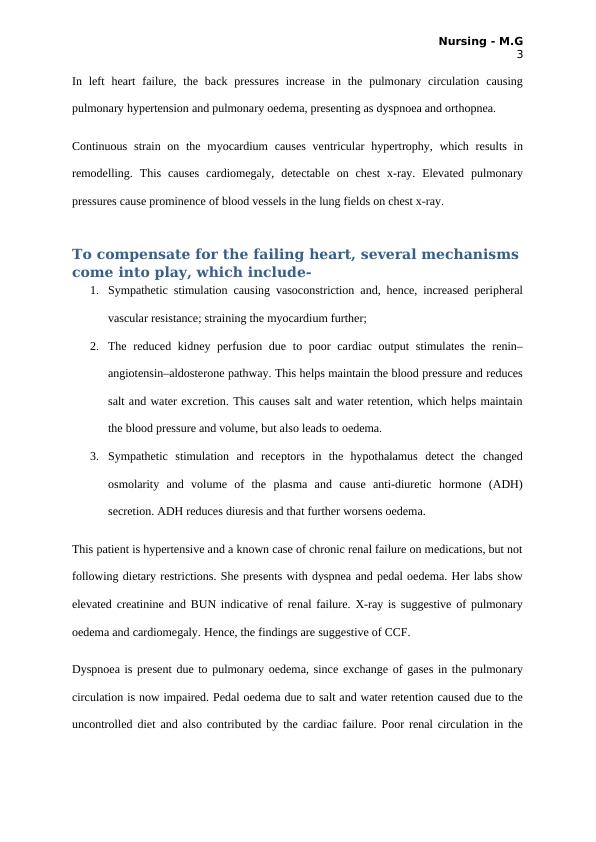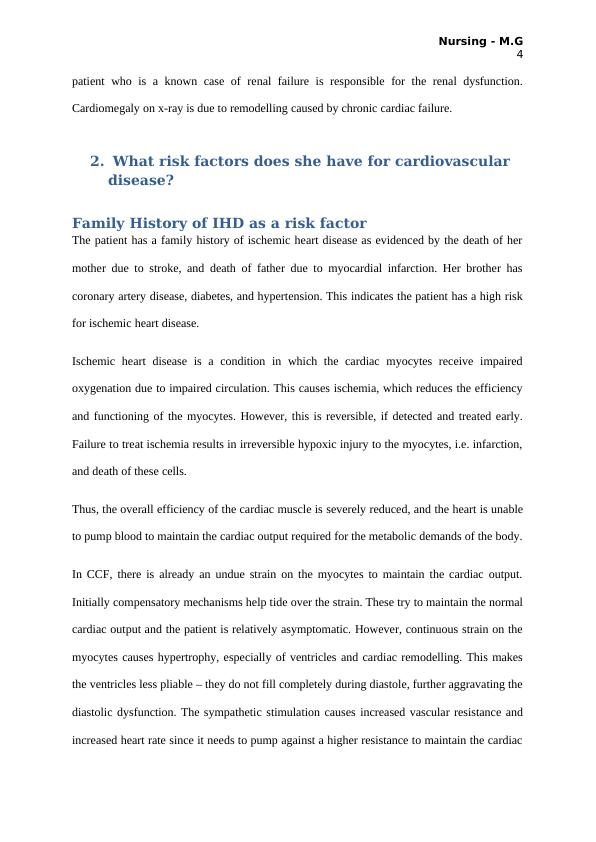Pathophysiology of Congestive Heart Failure
Added on 2020-01-28
12 Pages2522 Words61 Views
Nursing - M.G
1
Nursing - M.G
Student's Name:
Instructor's Name:
Date:
1
Nursing - M.G
Student's Name:
Instructor's Name:
Date:

Nursing - M.G
2
1. Describe the pathophysiology, health assessment
and clinical findings of M.G’s condition.
Pathophysiology of Congestive Heart Failure
Congestive heart failure (CCF) occurs when there is excessive strain on the myocardium to
meet the metabolic demands of the body, but it is unable to compensate for it. It may be
systolic dysfunction, diastolic dysfunction or both. Systolic dysfunction ensues when there is
pump failure. This causes a decreased ejection fraction and hence, a reduced stroke volume.
Poor stroke volume further strains the myocardium.
On exertion, such as exercise, the demand for oxygen increases multifold. The myocardium,
which was already under strain to maintain the cardiac output at rest, is further strained to
compensate for the increased demand for higher cardiac output. The myocardium now fails to
do so, resulting in exercise intolerance in these patients.
Diastolic dysfunction is due to failure of ventricular filling, which occurs mainly due to
cardiac remodelling. This causes ventricular stiffening and a reduced ability for ventricular
relaxation and filling. Due to this, there is a back pressure which is generated, that causes
elevated pulmonary pressures. High pulmonary vascular pressure ultimately results in
pulmonary oedema. This causes dyspnoea and orthopnea in the patients. In diastolic
dysfunction, ejection fraction is maintained.
Heart failure can also be classified into right heart failure, left heart failure, or both.
In right heart failure, the back pressures increase in the inferior vena cava and, hence, results
in congestive hepatomegaly. The patient presents with abdominal pain and pedal oedema as
the chief symptoms.
2
1. Describe the pathophysiology, health assessment
and clinical findings of M.G’s condition.
Pathophysiology of Congestive Heart Failure
Congestive heart failure (CCF) occurs when there is excessive strain on the myocardium to
meet the metabolic demands of the body, but it is unable to compensate for it. It may be
systolic dysfunction, diastolic dysfunction or both. Systolic dysfunction ensues when there is
pump failure. This causes a decreased ejection fraction and hence, a reduced stroke volume.
Poor stroke volume further strains the myocardium.
On exertion, such as exercise, the demand for oxygen increases multifold. The myocardium,
which was already under strain to maintain the cardiac output at rest, is further strained to
compensate for the increased demand for higher cardiac output. The myocardium now fails to
do so, resulting in exercise intolerance in these patients.
Diastolic dysfunction is due to failure of ventricular filling, which occurs mainly due to
cardiac remodelling. This causes ventricular stiffening and a reduced ability for ventricular
relaxation and filling. Due to this, there is a back pressure which is generated, that causes
elevated pulmonary pressures. High pulmonary vascular pressure ultimately results in
pulmonary oedema. This causes dyspnoea and orthopnea in the patients. In diastolic
dysfunction, ejection fraction is maintained.
Heart failure can also be classified into right heart failure, left heart failure, or both.
In right heart failure, the back pressures increase in the inferior vena cava and, hence, results
in congestive hepatomegaly. The patient presents with abdominal pain and pedal oedema as
the chief symptoms.

Nursing - M.G
3
In left heart failure, the back pressures increase in the pulmonary circulation causing
pulmonary hypertension and pulmonary oedema, presenting as dyspnoea and orthopnea.
Continuous strain on the myocardium causes ventricular hypertrophy, which results in
remodelling. This causes cardiomegaly, detectable on chest x-ray. Elevated pulmonary
pressures cause prominence of blood vessels in the lung fields on chest x-ray.
To compensate for the failing heart, several mechanisms
come into play, which include-
1. Sympathetic stimulation causing vasoconstriction and, hence, increased peripheral
vascular resistance; straining the myocardium further;
2. The reduced kidney perfusion due to poor cardiac output stimulates the renin–
angiotensin–aldosterone pathway. This helps maintain the blood pressure and reduces
salt and water excretion. This causes salt and water retention, which helps maintain
the blood pressure and volume, but also leads to oedema.
3. Sympathetic stimulation and receptors in the hypothalamus detect the changed
osmolarity and volume of the plasma and cause anti-diuretic hormone (ADH)
secretion. ADH reduces diuresis and that further worsens oedema.
This patient is hypertensive and a known case of chronic renal failure on medications, but not
following dietary restrictions. She presents with dyspnea and pedal oedema. Her labs show
elevated creatinine and BUN indicative of renal failure. X-ray is suggestive of pulmonary
oedema and cardiomegaly. Hence, the findings are suggestive of CCF.
Dyspnoea is present due to pulmonary oedema, since exchange of gases in the pulmonary
circulation is now impaired. Pedal oedema due to salt and water retention caused due to the
uncontrolled diet and also contributed by the cardiac failure. Poor renal circulation in the
3
In left heart failure, the back pressures increase in the pulmonary circulation causing
pulmonary hypertension and pulmonary oedema, presenting as dyspnoea and orthopnea.
Continuous strain on the myocardium causes ventricular hypertrophy, which results in
remodelling. This causes cardiomegaly, detectable on chest x-ray. Elevated pulmonary
pressures cause prominence of blood vessels in the lung fields on chest x-ray.
To compensate for the failing heart, several mechanisms
come into play, which include-
1. Sympathetic stimulation causing vasoconstriction and, hence, increased peripheral
vascular resistance; straining the myocardium further;
2. The reduced kidney perfusion due to poor cardiac output stimulates the renin–
angiotensin–aldosterone pathway. This helps maintain the blood pressure and reduces
salt and water excretion. This causes salt and water retention, which helps maintain
the blood pressure and volume, but also leads to oedema.
3. Sympathetic stimulation and receptors in the hypothalamus detect the changed
osmolarity and volume of the plasma and cause anti-diuretic hormone (ADH)
secretion. ADH reduces diuresis and that further worsens oedema.
This patient is hypertensive and a known case of chronic renal failure on medications, but not
following dietary restrictions. She presents with dyspnea and pedal oedema. Her labs show
elevated creatinine and BUN indicative of renal failure. X-ray is suggestive of pulmonary
oedema and cardiomegaly. Hence, the findings are suggestive of CCF.
Dyspnoea is present due to pulmonary oedema, since exchange of gases in the pulmonary
circulation is now impaired. Pedal oedema due to salt and water retention caused due to the
uncontrolled diet and also contributed by the cardiac failure. Poor renal circulation in the

Nursing - M.G
4
patient who is a known case of renal failure is responsible for the renal dysfunction.
Cardiomegaly on x-ray is due to remodelling caused by chronic cardiac failure.
2. What risk factors does she have for cardiovascular
disease?
Family History of IHD as a risk factor
The patient has a family history of ischemic heart disease as evidenced by the death of her
mother due to stroke, and death of father due to myocardial infarction. Her brother has
coronary artery disease, diabetes, and hypertension. This indicates the patient has a high risk
for ischemic heart disease.
Ischemic heart disease is a condition in which the cardiac myocytes receive impaired
oxygenation due to impaired circulation. This causes ischemia, which reduces the efficiency
and functioning of the myocytes. However, this is reversible, if detected and treated early.
Failure to treat ischemia results in irreversible hypoxic injury to the myocytes, i.e. infarction,
and death of these cells.
Thus, the overall efficiency of the cardiac muscle is severely reduced, and the heart is unable
to pump blood to maintain the cardiac output required for the metabolic demands of the body.
In CCF, there is already an undue strain on the myocytes to maintain the cardiac output.
Initially compensatory mechanisms help tide over the strain. These try to maintain the normal
cardiac output and the patient is relatively asymptomatic. However, continuous strain on the
myocytes causes hypertrophy, especially of ventricles and cardiac remodelling. This makes
the ventricles less pliable – they do not fill completely during diastole, further aggravating the
diastolic dysfunction. The sympathetic stimulation causes increased vascular resistance and
increased heart rate since it needs to pump against a higher resistance to maintain the cardiac
4
patient who is a known case of renal failure is responsible for the renal dysfunction.
Cardiomegaly on x-ray is due to remodelling caused by chronic cardiac failure.
2. What risk factors does she have for cardiovascular
disease?
Family History of IHD as a risk factor
The patient has a family history of ischemic heart disease as evidenced by the death of her
mother due to stroke, and death of father due to myocardial infarction. Her brother has
coronary artery disease, diabetes, and hypertension. This indicates the patient has a high risk
for ischemic heart disease.
Ischemic heart disease is a condition in which the cardiac myocytes receive impaired
oxygenation due to impaired circulation. This causes ischemia, which reduces the efficiency
and functioning of the myocytes. However, this is reversible, if detected and treated early.
Failure to treat ischemia results in irreversible hypoxic injury to the myocytes, i.e. infarction,
and death of these cells.
Thus, the overall efficiency of the cardiac muscle is severely reduced, and the heart is unable
to pump blood to maintain the cardiac output required for the metabolic demands of the body.
In CCF, there is already an undue strain on the myocytes to maintain the cardiac output.
Initially compensatory mechanisms help tide over the strain. These try to maintain the normal
cardiac output and the patient is relatively asymptomatic. However, continuous strain on the
myocytes causes hypertrophy, especially of ventricles and cardiac remodelling. This makes
the ventricles less pliable – they do not fill completely during diastole, further aggravating the
diastolic dysfunction. The sympathetic stimulation causes increased vascular resistance and
increased heart rate since it needs to pump against a higher resistance to maintain the cardiac

End of preview
Want to access all the pages? Upload your documents or become a member.
Related Documents
Pathophysiology of Chronic Systolic Heart Failure and Nursing Strategieslg...
|8
|1854
|121
Heart failure pathophysiology Assignment 2022lg...
|21
|3620
|6
Case Study Assessment: Congestive Heart Failure and Chronic Renal Failurelg...
|12
|3791
|341
Case study on Adult Assignmentlg...
|12
|3852
|155
001293G - Assignment on Bachelor of Nursinglg...
|7
|1603
|63
Drugs That May Cause or Exacerbate Heart Failurelg...
|8
|2025
|23